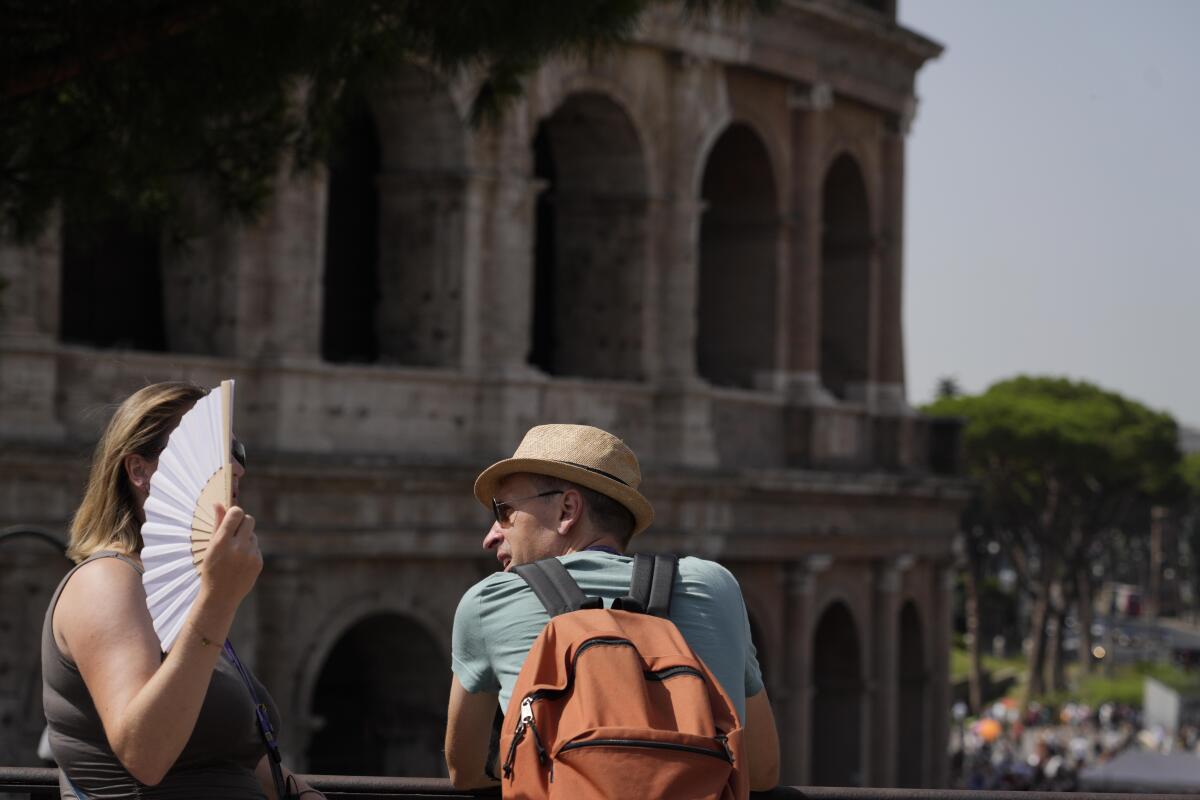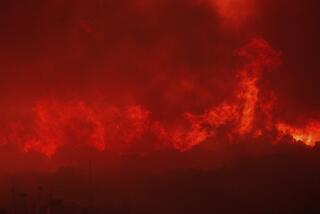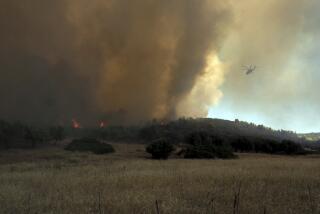Heat wave bakes Southern Europe, sparking warnings to stay hydrated and indoors

- Share via
ROME — Italian health officials intensified heat warnings Monday as Southern Europe began a brutally hot week with temperatures expected to top 104 degrees on a continent overburdened with summer tourists.
Countries with borders on the Mediterranean Sea weren’t alone in suffering. Authorities in North Macedonia extended a heat alert for the next 10 days with predicted temperatures topping 109 degrees while Kosovo also issued heat warnings.
“Never in my life have I experienced heat like this before in Pristina,” Artan Kelani, a 22-year-old student, said in Kosovo’s capital, where it reached 94 degrees Monday and was expected to get hotter starting Wednesday.
The Italian Health Ministry urged regions to beef up house-call services so that older people don’t have to go out if they need medical care and to set up dedicated heat stations at hospitals to treat emergency cases. Rome braced for temperatures as high as 107 degrees Fahrenheit on Tuesday.
The Italian capital’s civil protection office, volunteers and officials from the local water company plan to be at 28 locations, including the ancient Colosseum and open-air produce markets, to guide residents and tourists to fountains and to distribute bottled water.
The city government said that having volunteers fan out through the city would help hasten the arrival of medical help for people who seem to be suffering ill effects from the heat.
The culprit for the hot weather is a high-pressure anticyclone dubbed Cerberus, the multi-headed dog that guards the gates to Hades, the underworld in Greek mythology. Europe’s third heat wave in a month is expected to affect much of the Mediterranean and last until Wednesday.
“The bubble of hot air that has inflated over Southern Europe has turned Italy and surrounding countries into a giant pizza oven,” Hannah Cloke, a climate scientist and physical geographer at the University of Reading in England, said in a statement. “The hot air which pushed in from Africa is now staying put, with settled high pressure conditions meaning that heat in warm sea, land and air continues to build.”
Scientists say crushing temperatures that blanketed Europe last summer may have led to more than 61,000 extreme-heat-related deaths.
The mercury in Rome hit 102 degrees just before 3 p.m. Monday. Power outages were hitting parts of the city as electric grids suffered under heavier demand from air conditioners.
While the Italian capital’s hot spell was tough on tourists trekking through the cobblestone streets, tourist industry workers sweated through it.
Prince Mack, who is from Liberia, kept hydrated as he hawked tickets to open-top tour buses near central Rome’s Piazza Venezia. “I drank about six of these [water bottles] since this morning, and I’m still going to drink more,” he said at midday.
The Ministry of Health issued 10 recommendations to protect older adults, vulnerable people and and pets from the heat. The guidance included staying indoors and avoiding strenuous exercise during the hottest hours of the day and drinking at least nearly a half-gallon of water daily.
Local celebrities went on state-run RAI television to read the recommendations aloud and get the message out.
Besides Rome, several other cities, in particular on the southern islands of Sicily and Sardinia, were expected to top 104 on Tuesday.
Animals were stressed, too. Italian farm lobby Coldiretti noted that cows are producing around 10% less milk as a result of the heat.
Spain’s Aemet weather agency said the heat wave this week “will affect a large part of the countries bordering the Mediterranean.” Temperatures in some southern areas of Spain were forecast to exceed 107 degrees before dropping at some point Wednesday.
Aemet spokesperson Rubén del Campo said that as Cerberus pushes a hot mass of air from Africa toward Europe, the heat and very dry air would cause the risk of wildfires to skyrocket.
A wildfire that started Saturday on the Canary island of La Palma continued to burn out of control Monday, although authorities say weaker winds and cooler temperatures in the area are helping firefighters combat it. The blaze has burned some 11,300 acres of mostly woodland hills and some 20 houses and buildings.
More than 4,000 residents were evacuated from their homes Saturday but were allowed to return as of late Sunday.
Heat waves and drought swept across much of Europe last summer, with the temperature in Britain rising above 104 degrees for the first time on record.
The agency says it expects temperatures to drop sometime Wednesday.
Greece got a brief respite from the heat Monday, with opening hours returning to normal at the ancient Acropolis and other sites. But two wildfires threatened homes in areas outside Athens, where winds of up to 45 mph made the flames difficult to contain.
Most of southern Greece, including greater Athens, was at an elevated level of alert for fire risk, while more extreme temperatures are expected starting Thursday.
More to Read
Sign up for Essential California
The most important California stories and recommendations in your inbox every morning.
You may occasionally receive promotional content from the Los Angeles Times.












